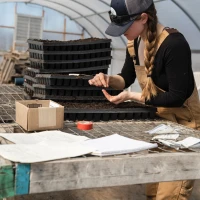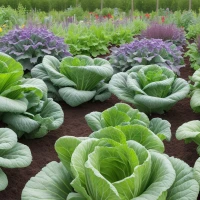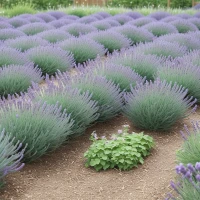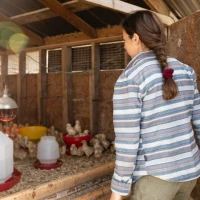Are you an avid gardener or a commercial farmer looking to increase your sweet potato yield naturally? Companion planting is an age-old agricultural practice designed to enhance plant health and yields through strategic placement of complementary species. In this in-depth guide, we’ll unveil the top companion plants to sweet potatoes that can elevate your garden’s productivity to new heights.
Sweet potatoes (Ipomoea batatas) are a nutritious and versatile crop that thrives in many climates. By harnessing the power of companion planting, you can optimize your sweet potato harvest, creating a symbiotic environment that promotes growth and deters pests. Let’s dig into the specifics of how certain plants can complement sweet potatoes, improve soil health, and contribute to a bountiful harvest.
The Magic of Companion Planting for Sweet Potatoes
Before we delve into specific companions, understanding the benefits of companion planting is crucial. This method builds a supportive network among different plant species, enhancing your garden’s overall ecosystem.
Why Companion Plant for Sweet Potatoes?
- Pest Deterrence: Certain companion plants can repel pests that target sweet potatoes, reducing the need for chemical pesticides.
- Soil Enhancement: Companions can contribute to a more fertile soil with better structure and nutrient availability.
- Space Maximization: Efficient use of space allows for a more productive garden with canopies providing shade and ground covers preventing weed overgrowth.
- Biodiversity: A variety of plants attract beneficial insects and birds that contribute to pollination and pest control.
The Ultimate Companion Plants for Sweet Potatoes: Unveiled
Now, let’s get to the heart of the matter – the best companion plants for sweet potatoes that can help you amplify your crop yield.
Marigolds: The Vibrant Defender
Marigolds are not only a vibrant addition to your garden, but they are also champions in deterring nematodes – tiny parasites that attack sweet potato roots. Planting marigolds a season before your sweet potatoes prepare the soil to be more welcoming to your tuberous crop.
Nasturtiums: The Alluring Shield
Nasturtiums, with their bright flowers and lush greenery, serve an essential function in your garden. They lure aphids and other pests away from your sweet potatoes, acting as a sacrificial plant. Plus, their flowers are edible, adding another layer of utility and charm.
Beans: Nitrogen-Rich Partners
Beans, particularly bush varieties, are fantastic friends to sweet potatoes. They infuse the soil with nitrogen, a critical nutrient that sweet potatoes require for robust growth. Beans also offer a living mulch that retains soil moisture.
Summer Savory: The Flavorful Companion
This herb not only enhances the flavor profile of your garden but also has the hidden talent of discouraging sweet potato weevils. Summer savory also attracts pollinators, providing a dual advantage as a companion plant.
Deep Dive: Enhancing Sweet Potato Growth Through Plant Synergy
Gardening isn’t just about planting crops; it’s about cultivating an environment where plants can flourish in harmony. Below are some additional companion planting strategies that are effective in augmenting your sweet potato yield.
Understand Companion Planting Dos and Don’ts
- DO: Rotate crops frequently to prevent disease and pests.
- DON’T: Place sweet potatoes too close to competing plants like squash or pumpkins.
Maximize Companion Planting Benefits
- Use vertical space: Grow tall or climbing plants to provide shade for sweet potatoes during the hottest parts of the day.
- Incorporate diversity: A mix of companion plants can stave off a wide range of pests and diseases.
Be Strategic with Plant Placement
- Consider growth patterns: Sweet potatoes need room to sprawl; plan your garden layout to allow for their expansion.
- Opt for edge planting: Use companion plants around the perimeter of your sweet potato patch to create a barrier against pests.
Creating a Companion Planting Plan for Sweet Potatoes
To practically apply these insights, creating a detailed companion planting plan is essential. Below you’ll find ways to map out your garden for optimal sweet potato development.
Determine Garden Layout and Spacing
- Allocate sufficient space for each sweet potato plant – generally about 12-18 inches apart.
- Cluster companion plants in groups to create a striking visual impact and a concentrated defense against pests.
Choose Your Companion Planting Palette
- Select a mix of flowers, herbs, and other vegetables that can coexist with sweet potatoes. This includes marigolds, nasturtiums, beans, summer savory, and more.
Schedule Planting Times
- Plant marigolds and nasturtiums ahead of sweet potatoes to allow them to establish a presence.
- Synchronize bean planting time with sweet potatoes to ensure simultaneous growth and benefit sharing.
Troubleshooting Common Challenges in Companion Planting
Even the best-laid plans can encounter difficulties. Here are some common issues that may arise in your companion planted sweet potato garden and how to address them.
Pest Invasions Despite Companion Plants
- Introduce beneficial insects: Ladybugs and lacewings can help control pest populations.
- Employ physical barriers: Nets and row covers might be necessary to protect your plants.
Companion Plants Overcrowding Sweet Potatoes
- Prune aggressively: Keep your companion plants in check to avoid overshadowing sweet potatoes.
- Practice selective harvesting: Remove some companion plants if they’re competing for resources.
Nutrient Competition Among Plants
- Enrich the soil: Compost and organic fertilizers can help provide enough nutrients for all your plants.
- Monitor plant health: Look out for signs of nutrient deficiencies and adjust your fertilization plan accordingly.
Bringing It All Together: The Art of Companion Planting for Sweet Potatoes
As we’ve explored, companion plants can significantly influence the success of your sweet potato harvest. By implementing these strategic partnerships, you invite a holistic approach to gardening that yields more than just crops – it fosters an ecosystem teeming with life and bounty.
In summary, to maximize the potential of your sweet potato yield through companion planting, always:
- Focus on building a diverse garden ecosystem with flowering plants, legumes, and herbs.
- Be mindful of spacing, layout, and timing to ensure each plant has the opportunity to thrive.
- Monitor and adjust your strategies based on what you observe in your garden, learning and evolving with each season.
Harness the connections between plants, leverage their unique characteristics, and watch as your sweet potatoes and their companions grow stronger together. Your efforts will be rewarded not only with a bountiful harvest but also with the intrinsic satisfaction of creating a vibrant, sustainable garden space.
Remember, the journey of a gardener is continuous, filled with trials, learnings, and, ultimately, the sweet (potato) success of harvest days. Happy planting, and may your garden flourish with the synergy of companion plants!










